11.1 Upgrading Using a Wizard or Script
There are two platform-based options for upgrading to ZENworks 7 with SP1 using a wizard or script:
-
NetWare and Windows servers: For these platforms, the wizards are started on the Windows workstation from installation menu options run from an executable file run from the Novell ZENworks 7 Server Management with Support Pack 1 Program CD.
Policy and Distribution Services can be upgraded to ZENworks 7 with SP1 using this method. However, if you want to use a GUI upgrade program for version 3.0.2 Policy and Distributions Services, you must use the upgrade program described in Section 12.0, Version 3.0.2 Policy and Distribution Services, and not the upgrade program described in this section.
The Distributor and Subscriber servers can be upgraded to ZENworks 7 with SP1 in any order.
-
Linux and Solaris servers: For these platforms, a script file is used. It is provided on the Novell ZENworks 7 with Support Pack 1 Companion 2 CD and is run locally on each Linux or Solaris server to be upgraded.
Only Policy and Distribution Services 6.5 or later can be upgraded using this method.
To automate installation to multiple Subscriber servers on all supported platforms, we recommend upgrading these servers using the Server Software Package method (see Section 11.2, Upgrading Using a Server Software Package), which can be used to upgrade all previous versions (3.0.2, 6.5, 6.5 SP1, and 6.5 SP2).
To upgrade to ZENworks 7 with SP1 Policy and Distribution Services using a wizard or script, continue with the applicable sections:
11.1.1 Upgrade Concepts and Issues
Review the following to understand what the upgrade does, and to understand the issues involved:
What the Upgrade Does and Does Not Do
In the following table, the applicable Server Management components are indicated for the upgrade actions:
Table 11-1 Upgrade Actions
|
Action |
P |
|---|---|
|
Upgrades ZENworks for Servers 3.0.2 Policy and Distribution Services to ZENworks 7 with SP1. |
F |
|
Upgrades ZENworks Server Management 6.5, 6.5 SP1, 6.5 SP2, or 7 Policy and Distribution Services to ZENworks 7 with SP1. |
T |
|
Installs Policy and Distribution Services components where they were previously not installed. |
F |
|
Upgrades Novell eDirectory™ objects. |
T |
|
The GUI wizard upgrades the ZENworks 6.5 Policy and Distribution Services software to version 7 on the servers where it discovers upgradable software. It uses the installation paths where ZENworks 6.5 was installed. |
T |
|
The script upgrades ZENworks 6.5 Policy and Distribution Services software to version 7 on the Linux or Solaris machines where you locally run the script. |
T |
|
In the GUI wizard, you cannot select or deselect any check boxes. Their status is determined by the wizard when you select the machines for upgrading. |
T |
|
The wizard automatically stops and restarts the services, if they are running. It leaves the services in the same state they were in before upgrading. |
T |
|
The services are not restarted if they are not running before the wizard started. |
T |
|
You have an option to restart the services if they are not running before the wizard started. |
F |
|
Files are always copied, replacing both older and newer files with the upgraded files. Files copied to locations outside of the ZENworks directories are replaced only if they are older. |
T |
|
If you already have a hook driver installed on the machine where you are upgrading, the hook driver is uninstalled during the upgrade. |
– |
|
The wizard upgrades the ConsoleOne® snap-ins to ZENworks 7 with SP1 on both the installation workstation and any target servers where ConsoleOne is found by the wizard. For the ConsoleOne check box to show as selected, version 6.5 or later of the snap-ins must have been previously installed. |
T |
|
In the wizard, you cannot select workstations where ConsoleOne is installed to update the Server Management snap-ins there. You must run the wizard on each workstation where you have the snap-ins installed in order to locally update them. |
T |
|
The ZENworks 6.5 Policy and Distribution Services plug-ins for iManager are not upgraded by the menu option. You must do this with the menu option after you have exited the upgrade wizard. This task is covered in Upgrading the Novell iManager Plug-Ins. Also, if you have iManager 2.0.2, 2.5, or 2.6 installed, you can install the plug-ins for the first time using the task covered in Upgrading the Novell iManager Plug-Ins. |
T |
NOTE:P = Policy and Distribution Services; T = true; F = false; and, – = not applicable.
Upgrading Servers Incrementally
You can upgrade all ZENworks servers to version 7 in one pass, or incrementally (such as for geographical locations).
The wizard copies files to each server, one server after another. If you have many Subscribers, consider the time that it might take to upgrade them. If that time frame is too long, select your target Subscribers in groups so that you can upgrade one group at a time, or use the software package upgrade method.
Because upgrading Policy and Distribution Services on Linux and Solaris servers is done locally one at a time using a script, incremental upgrading doesn’t apply. If you want to perform incremental upgrades of groups of Linux or Solaris servers, consider using a Server Software Package.
For more information on upgrading with software packages, see Section 11.2, Upgrading Using a Server Software Package.
Upgrading Servers on Multiple Trees
When selecting servers in the wizard, you select them by their NCP Server objects, not their ZENworks objects. If your ZENworks servers reside in multiple trees, you must be logged into each of those trees to be able to select the servers.
You can also upgrade servers across multiple trees by using a Server Software Package (see Section 11.2, Upgrading Using a Server Software Package).
Cluster Issues with Upgrading
Review the following cluster issues:
Upgrading Cluster Ready versus Cluster Aware Servers
When you select servers for installing ZENworks 7 with SP1, you can select both the virtual server’s cluster object and the NCP Server objects of the node servers in the cluster, and the installation program allows you to install to both the virtual server and its nodes. However, if you install ZENworks 7 with SP1 to both, you will have two different locations for the zfs.ncf startup file and it will be run from both locations, causing errors. Therefore, you must know whether you installed Server Management in a cluster ready or cluster aware environment before you select where to install ZENworks 7 with SP1.
If your ZENworks servers are installed as cluster ready:
-
You must select only the virtual server object to install ZENworks 7 with SP1
-
The ZENworks 7 with SP1 installation copies files to each node in the cluster
-
The ZENworks 7 with SP1 installation sets up one zfs.ncf file for the cluster
If your ZENworks servers are installed as cluster aware:
-
You must select only the node servers’ NCP Server objects to install ZENworks 7 with SP1
-
The ZENworks 7 with SP1 installation copies files to each node in the cluster
-
The ZENworks 7 with SP1 installation sets up the zfs.ncf file on each node’s server
For more information, see Section F.0, ZENworks Server Management in a Clustered Environment.
Cannot Upgrade Clustered Servers Using the Server Software Packages
The Novell ZENworks 7 with Support Pack 1 Companion 2 CD includes the following Server Software Package for Policy and Distribution Services:
zsm7_polydist.cpk
Server Software Packages cannot be used to upgrade clustered servers to ZENworks 7 with SP1 for the following reasons:
-
Server Software Packages do not have eDirectory access
-
Server Software Packages can only update the local box, leaving the other nodes not updated
11.1.2 Selecting the Servers to Upgrade
-
Incremental issues: In determining which servers you want to upgrade to ZENworks 7 with SP1, consider any incremental upgrade issues. For more information, see Upgrading Servers Incrementally.
-
Servers to be upgraded using a wizard: If you plan to run the wizard, you might be able to wait until you are running the wizard to determine which servers to upgrade, because you can use one of the following methods for selecting NetWare® and Windows servers:
-
If a small percentage of your servers have an earlier version of ZENworks installed on them, and you know the NCP Server object names of the servers that have ZENworks installed on them, you can individually select those servers when you are running the wizard.
-
If a large percentage (or all) of your servers have an earlier version of ZENworks installed on them, you can select all of the servers in the tree or selected context. Only those that have upgradable ZENworks components installed on them are listed on the Server Selection page for upgrading.
-
-
Servers to be upgraded using a Server Software Package: If you plan to use the Server Software Package method, determine which servers you want to upgrade:
-
If a small percentage of your servers have an earlier version of ZENworks installed on them, you can include all of your Subscriber servers in the Channel that you create for the Distribution. When you select a Subscriber server to be upgraded that also has the Distributor software on it, that software is also upgraded.
-
If a large percentage of your servers have an earlier version of ZENworks installed on them and you want to upgrade them incrementally, such as by geographic region, identify which servers you want in each group so that you can subscribe them to the Channels that you create for each group.
When upgrading using a software package, you can create a unique Channel for the upgrade Distribution, then subscribe the Subscribers to be upgraded to that Channel.
-
-
Servers to be upgraded using a script: If you do not plan to use the Server Software Package method for upgrading Linux or Solaris servers, identify the servers where you need to run the script.
11.1.3 Upgrading Policy-Enabled Server Management on NetWare and Windows Servers
To upgrade ZENworks 6.5 or 7 Policy-Enabled Server Management to ZENworks 7 with SP1, perform the following tasks in order:
Pre-upgrade Checklist
-
Review the Novell ZENworks 7 Server Management with Support Pack 1 Readme on the ZENworks 7 Web site for any last-minute information concerning upgrading to version 7.
-
Make sure that a previous version of ZENworks Server Management is installed on the servers you want to upgrade to version 7.
-
Make note of any clustered servers and determine whether they have ZENworks installed as cluster ready or cluster aware. For more information, see Cluster Issues with Upgrading.
-
If you have any instance of ConsoleOne running on a target server via a mapped drive from a workstation, or it is running from the installation machine, exit those instances of ConsoleOne before running the installation program.
If ConsoleOne is running on a target server via a mapped drive on your installation machine, or if it is running from the installation machine, the ZENworks Server Management snap-ins for ConsoleOne cannot be installed at those locations.
-
If you have not already done so, log in to the eDirectory trees that contain the NCP Server objects for the servers where you are updating the ZENworks software.
You are automatically authenticated to all of the target NetWare servers in the trees you are logged in to during installation, so that you can select those servers for installing the Server Management software.
If you are not logged in to a tree, you cannot select its server objects during the upgrade process.
You can run the wizard as many times as necessary.
-
If you install software to any Windows servers, make sure that you have authenticated to those servers.
This enables you to select Windows servers from their domains for installing the Distributor and Subscriber software. However, if you are not logged in to a Windows server before starting the installation, you can authenticate during installation using a username and password in the Add Server dialog box where you select the Windows server for installation.
-
If you install software to any Windows servers, make sure you have closed the Services window on each Windows server.
The installation program automatically stops all ZENworks Server Management services. However, the Server Management services cannot be registered if the Services window is left open during installation to the server.
Upgrading to ZENworks 7 with SP1
To upgrade previous versions of ZENworks to ZENworks 7 Server Management with SP1, do the following tasks in order:
Start the Installation Program
-
On the upgrade workstation, insert the Novell ZENworks 7 Server Management with Support Pack 1 Program CD.
The startup screen is displayed. If the startup screen is not automatically displayed after inserting the CD, run winsetup.exe at the root of the CD.
We recommend that you upgrade Policy and Distribution Services from the Program CD. However, if you need to copy the CD structure to a hard drive, the path between the root of the hard drive and the first CD directory can contain only directory names that conform to the 8.3-character DOS file naming convention. If any long directory names exist in the path, the upgrade program does not work.
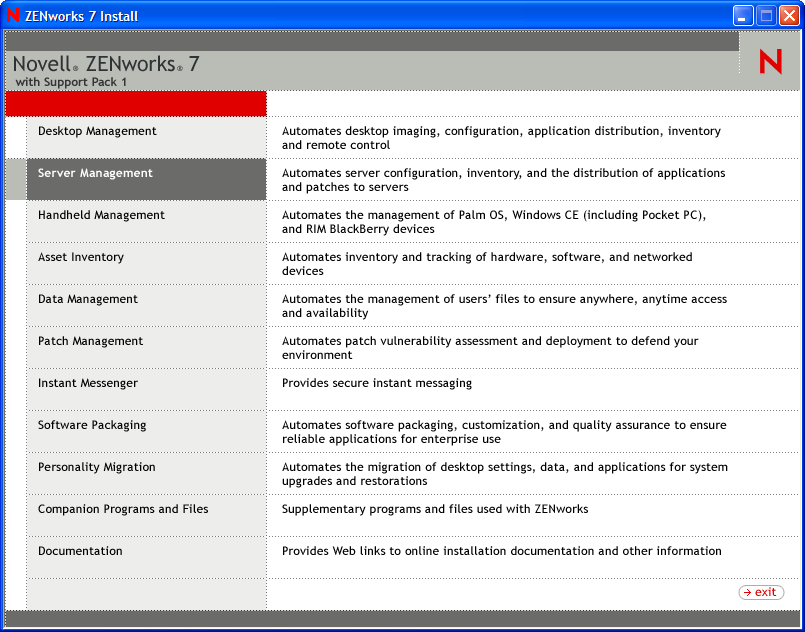
-
On the main menu, select .
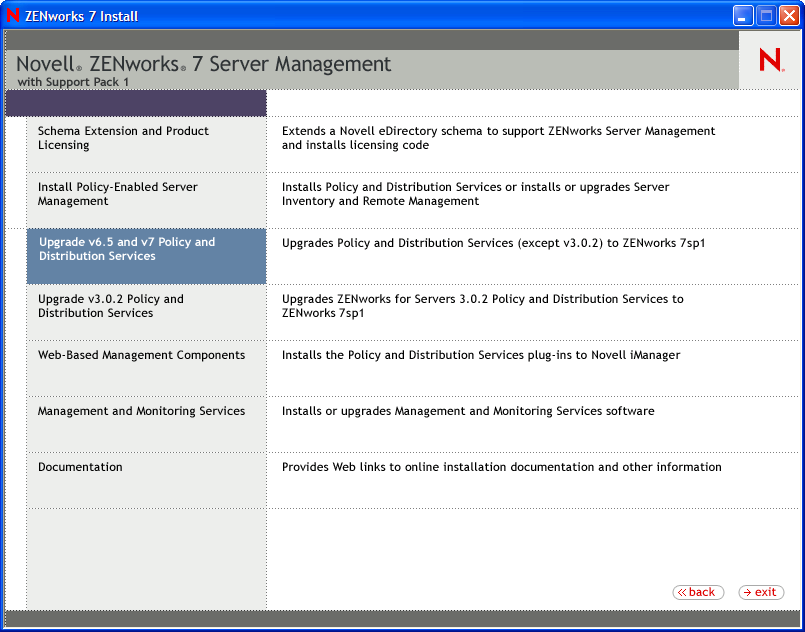
-
Select to start the wizard and display the License Agreement page.
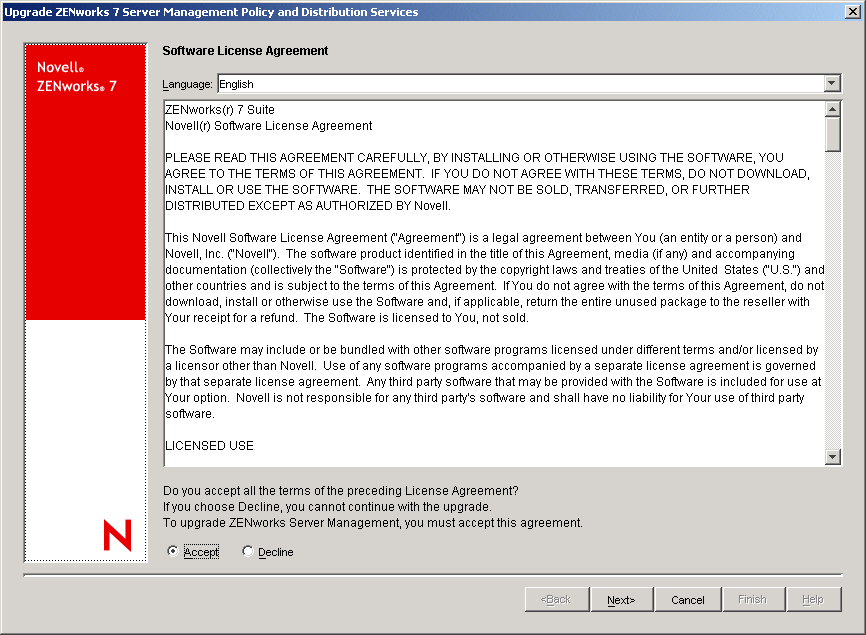
-
If you agree to the Software License Agreement, click , then click ; otherwise, click to exit.
The Server Selection page is displayed with only the option and its check box enabled, if the ZENworks snap-ins are installed on that machine.
-
Continue with Select the Servers to Upgrade.
Select the Servers to Upgrade
Figure 11-1 Support Pack Upgrade Server Selection Page
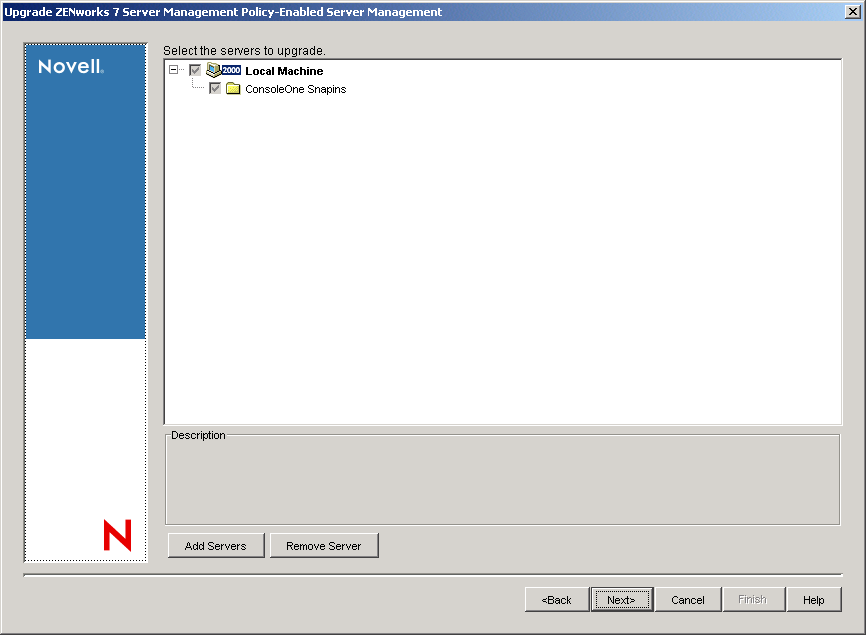
-
On the Server Selection page, click to display the Add Servers dialog box.
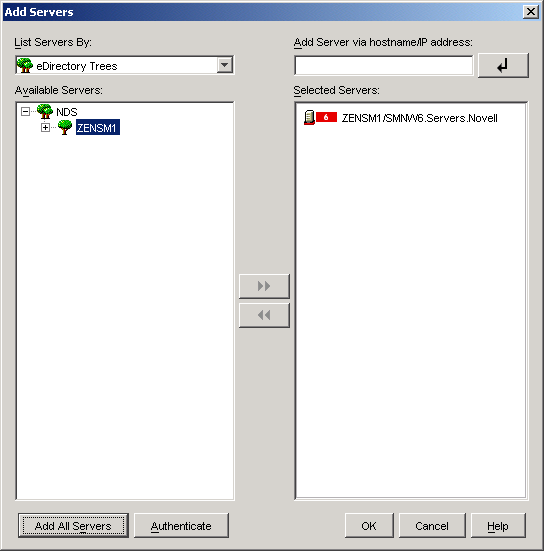
-
Browse for the NCP Server objects for the servers that you want to upgrade, then click .
You can browse for NetWare servers by selecting eDirectory Trees from a drop-down box, or browse for Windows servers by selecting Microsoft Domains (or Microsoft Active Directory) from a drop-down box. You can select servers in the following ways:
-
Select servers individually or in multiples by using the Ctrl and Shift keys.
-
Select servers in groups by selecting eDirectory containers, Windows workgroups, or Microsoft domains, then clicking the button.
-
Select all NetWare servers in the tree by selecting the tree and then clicking the button.
IMPORTANT:If you select , the list box includes servers that cannot be upgraded (such as those that do not have ZENworks 6.5 installed). Then, when you click to continue, those servers are not included on the Server Selection page. However, for each server that is not included, a message is displayed indicating this, and you must click to continue. To speed up the process, if you can determine in the list box which servers do not have ZENworks 6.5 installed, remove them from this list before clicking to continue to the Server Selection page.
For more information on using the Add Servers dialog box, click its button.
Make sure that you have selected all of the NetWare and Windows servers that you want to upgrade to version 7 before exiting the Add Servers dialog box.
The selected servers are displayed below the option on the Server Selection page:
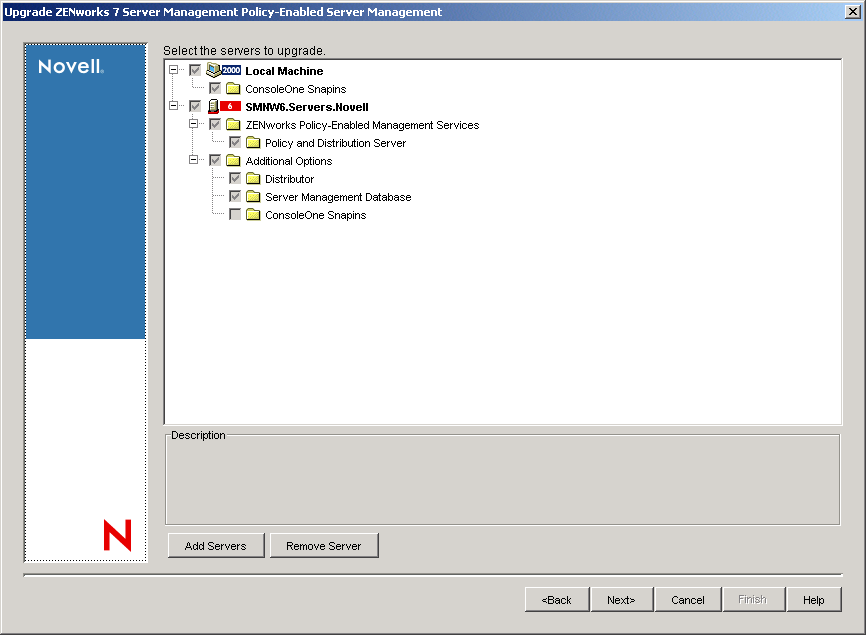
The ZENworks components that have been previously installed that are eligible to be upgraded to version 7 are indicated by a check mark in their check boxes. Click the plus signs to expand the tree structure to view the components. You cannot enable or disable any of the check boxes. They only show what is upgraded.
-
-
You cannot install version 7 to both a virtual server’s cluster object and the NCP Server objects for each of its nodes; therefore, if you have selected both, you must remove one or the other to prevent errors caused by zfs.ncf being run from two different locations in the cluster.
For more information, see Cluster Issues with Upgrading.
-
Click and continue with Review the Upgrade Summary.
Review the Upgrade Summary
Figure 11-2 Support Pack Upgrade Summary Page
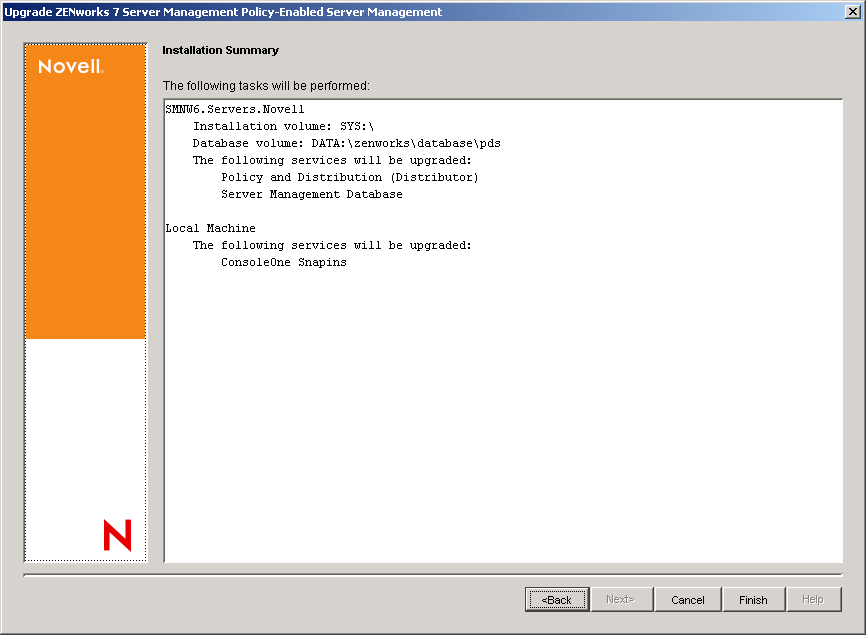
-
On the Installation Summary page, review the information to determine if the wizard will do what you planned.
You can click to make changes.
-
Click to begin the upgrade process.
-
After the upgrade wizard has finished, review the installation log file to determine whether any components failed to install.
The log file is located in the installation machine’s temporary directory as determined in its Windows environment settings. For example:
%temp%\_resnnn.txtwhere nnn is increased incrementally each time a new log is created.
-
After successfully upgrading the software, click to close the wizard.
At this time, the software is upgraded to version 7 and the Server Management services should be restarting on the upgraded servers, if those services are running on the server prior to being upgraded.
If a server did not have its Server Management services running before it was upgraded, you must restart them manually. These instructions are provided in the one of the next sections.
-
Continue with Upgrading the Novell iManager Plug-Ins.
or
Continue with Starting the Services.
Upgrading the Novell iManager Plug-Ins
This section is only applicable to Policy and Distribution Services.
If you have Novell iManager 2.0.2, 2.5, or 2.6 installed in your network, and you need to upgrade the iManager plug-ins to ZENworks 7 with SP1, or install the plug-ins for the first time, the processes for installing the iManager plug-ins is different for iManager 2.0.2 and iManager 2.5 or 2.6 in ZENworks 7 with SP1 and earlier:
Upgrading the Plug-ins to iManager 2.0.2
-
On the upgrade workstation, insert the Novell ZENworks 7 Server Management with Support Pack 1 Program CD.
The startup screen is displayed. If the startup screen is not automatically displayed after inserting the CD, run winsetup.exe at the root of the CD.

-
On the main menu, select .
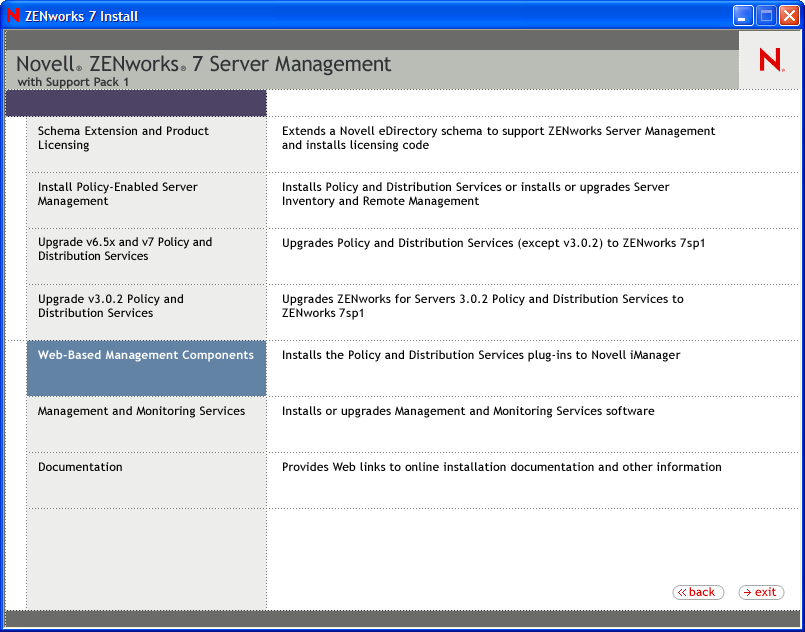
-
Select to start the wizard and display the License Agreement page.
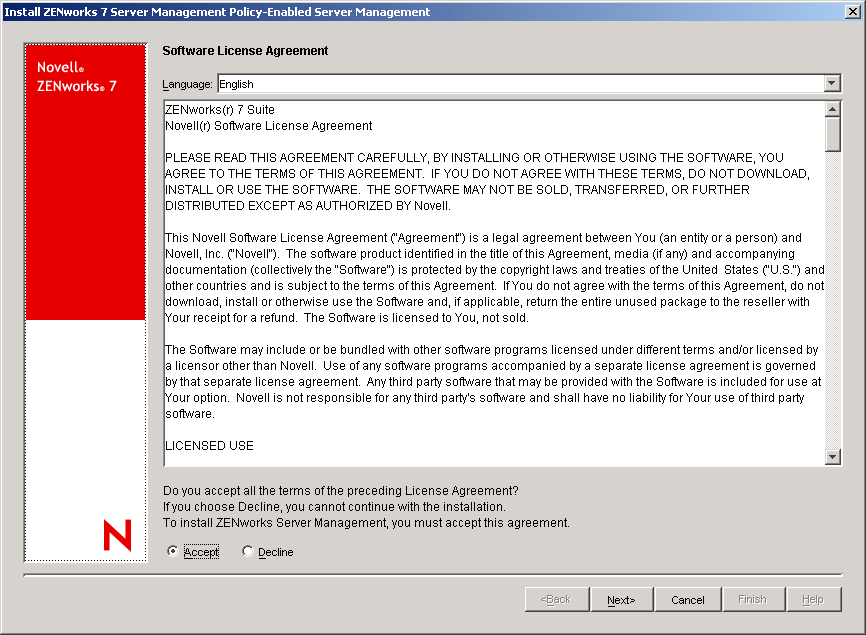
-
To accept the License Agreement, click , then click to view the Login Information page.
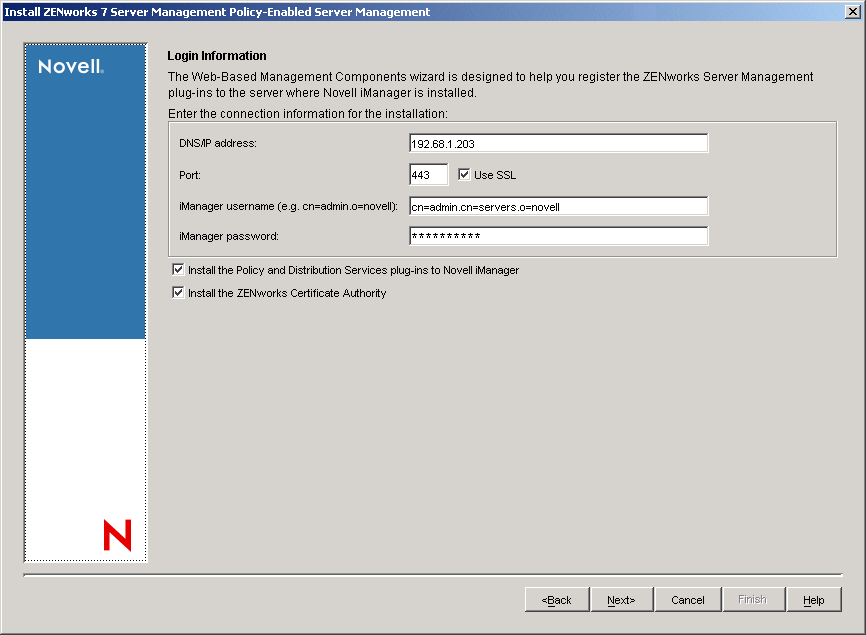
-
Fill in the fields:
DNS/IP address: Specify the address of the server where iManager is installed.
Port: Specify the port number to use when communicating with iManager. It is most likely 443 if SSL is used; if not, use 8080.
Use SSL: By default, this check box is not selected. If you have iManager configured to use SSL, you should enable this check box.
iManager username: Specify the iManager (fully distinguished) login name of the user with rights to iManager. This must be entered in the format indicated (for example, cn=admin.o=novell). Installation cannot continue if the username cannot authenticate.
iManager password: Specify the iManager password of the user running the wizard.
Install the Policy and Distribution Services plug-ins to Novell iManager: Select the check box to install the Remote Web Console and Tiered Electronic Distribution plug-ins to iManager so that you can manage these components from a Web browser.
Install the ZENworks certificate authority: Select the check box to install the ZENworks certificate authority servlet for inter-server communications security. This provides additional security to ensure that data received from outside your secured network is from a trusted source, that it has not been tampered with en route, and that the data received can be trusted by other machines. This is accomplished through the use of signed security certificates and digital signatures.
-
Click to view the Summary page.

The installation summary indicates that the selected Web components are to be installed to the Tomcat installation directory.
-
Click .
-
When the installation has completed, click to view the installation log file.
If the log file contains errors, you can print it for reference. To look up error messages, see Section H.0, Installation Error Messages. Correct the error, then repeat the installation steps.
The ZENworks Server Management role in iManager should still be set up, because the information for it is stored in eDirectory.
-
After successfully upgrading the iManager plug-ins, close the log file.
-
If you installed the plug-ins to iManager 2.5, do the following:
-
Log in to iManager 2.5.
-
When prompted with an install/upgrade task, install the new or updated plug-ins.
-
-
For iManager to recognize the new plug-ins, stop Tomcat, then restart Tomcat:
-
NetWare
Stop: tc4stop.ncf
Start: tomcat4.ncf
-
Windows
In the Services window, stop then start the Tomcat service by right-clicking the service and selecting the options.
-
Linux
Restart: /etc/init.d/tomcat4 restart
or
Stop: /etc/init.d/tomcat4 stop
Start: /etc/init.d/tomcat4 start
-
OES Linux
Restart: /etc/init.d/novell-tomcat4 restart
or
Stop: /etc/init.d/novell-tomcat4 stop
Start: /etc/init.d/novell-tomcat4 start
-
-
Continue with Starting the Services.
Upgrading the Plug-ins to iManager 2.5 or 2.6
-
Locate the Novell iManager plug-in module (NPM) on the Novell ZENworks 7 with Support Pack 1 Companion 1 CD:
\Novell iManager\ZFS Plugins NPM\ZFS_PolyDistPlugins.npm
-
Follow the instructions in your iManager documentation to install the NPM:
-
iManager 2.5: see the Novell iManager 2.5 Installation Guide
-
iManager 2.6: see the Novell iManager 2.6 documentation
-
-
Continue with Starting the Services.
Starting the Services
If the upgrade did not automatically stop and restart the services, or the services are not running before you upgraded the server, and you want the services to be running at this time, start the services at this time.
On NetWare Servers
-
Enter the following command at the server’s main console prompt:
zfs
This starts all of the Policy and Distribution Services services, including the database.
Continue with On Windows Servers or Verifying That the Services Are Running Successfully.
On Windows Servers
-
Open the Control Panel.
-
Double-click , then double-click .
-
Start the service.
This starts all of the Policy and Distribution Services services, including the database.
Continue with Verifying That the Services Are Running Successfully.
Verifying That the Services Are Running Successfully
On NetWare Servers
-
On each server’s console, press Ctrl+Esc to view the services:
- ASA 8.0.3 ... (if the Sybase database is installed)
- ZENworks (for Policy and Distribution Services)
-
If any service is missing, that component was not successfully started.
For steps to start a service, see On NetWare Servers.
-
After successfully starting the services, continue with On Windows Servers or Verifying That the Server Is Upgraded.
On Windows Servers
-
On each Windows server, open the Control Panel, double-click > , then determine if the following services are running:
- Novell Database - Sybase
- Novell ZENworks Service Manager
-
If any service is not running, that component was not successfully started.
For steps to start a service, see On Windows Servers.
-
After successfully starting the services, continue with Verifying That the Server Is Upgraded.
Verifying That the Server Is Upgraded
Using iManager
-
Log in to iManager.
-
Under the ZENworks Server Management role, select .
-
Identify a server (NetWare or Windows), then click .
You can either enter the IP address or DNS name, or browse for the server’s ZENworks object.
-
In the field, select from the drop-down list.
-
Under the tab, review the version information.
“ZENworks 7 Server Management with SP1” should be displayed.
-
Repeat these steps for each upgraded server.
On a NetWare Server
-
At the NetWare server’s main console prompt, enter the following command:
zfsversion
The zfsversion command also writes a listing of ZENworks .jar files and their dates to:
volume:\zenworks\zfsversion.log -
View the current Server Management version information.
If version 7 was applied correctly, it should read:
ZENworks Server Management - 7
-
Repeat these steps for each upgraded server.
-
If the version is correct for each server, continue with On a Windows Server or Repeating the Upgrade.
On a Windows Server
-
On the Windows server, run \zenworks\zfsversion.bat.
This creates a zfsversion.log file in the \zenworks directory.
-
Open the log file to view the current Server Management version information.
-
Repeat these steps for each upgraded server.
-
If the version is correct for each server, continue with Repeating the Upgrade.
Repeating the Upgrade
You might need to run the GUI wizard again for the following reasons:
-
If you are upgrading incrementally, repeat the upgrade instructions beginning with Upgrading to ZENworks 7 with SP1.
You can also do this at a later date, because ZENworks 6.5 servers that are upgraded to version 7 work with version 6.5 servers that are not yet upgraded to version 7. In other words, ZENworks 6.5 Distributors can send its Distributions to ZENworks 7 with SP1 Subscribers.
-
If you have other workstations where the Server Management snap-ins to ConsoleOne are installed, you can repeat the upgrade instructions beginning with Upgrading to ZENworks 7 with SP1 on each of those machines to upgrade them. You do not need to select any servers. This ConsoleOne upgrade on workstations can be performed at any time.
-
If you have Linux or Solaris servers to upgrade, continue with Section 11.1.4, Upgrading Policy and Distribution Services on Linux and Solaris Servers. Otherwise, you have completed upgrading Policy-Enabled Server Management to ZENworks 7 with SP1, except for the following post-upgrade task:
Post-Upgrade Manual Distribution Task
Manual Distributions created in ZENworks 6.5 or later do not work in version 7. You must re-create them using the version 7 Manual Distribution Wizard.
For steps on creating manual Distributions, see Manually Importing and Exporting Distributions
in the Novell ZENworks 7 Server Management Administration Guide.
11.1.4 Upgrading Policy and Distribution Services on Linux and Solaris Servers
The script for Linux and Solaris servers detects the existence of ZENworks 6.5 or later software and asks whether you want to upgrade or install. We recommend using the upgrade option, which is documented in the following steps.
To upgrade, do the following:
Running the Upgrade Script
Perform the following tasks individually on each Linux and Solaris server to upgrade it from ZENworks 6.5 or later Server Management to version 7:
-
Review the Novell ZENworks 7 Server Management with Support Pack 1 Readme on the ZENworks 7 Web site for any last-minute information concerning upgrading to version 7.
-
Log in as root.
-
If you are running X Windows on the Linux or Solaris server, open an XTerm window.
-
To run the Policy and Distribution Services script, enter one of the following commands in an XTerm window:
Red Hat Linux: /mnt/cdrom/ZfS/TedPol/platform/zfs-pds-upgrade
SUSE Linux: /media/cdrom/ZfS/TedPol/platform/zfs-pds-upgrade
where platform is either Linux or Solaris.
-
Press Enter to display the license agreement, press the Spacebar to scroll through the license agreement, type y, then press Enter to accept the license agreement.
The following is displayed (including errors, if any) for a Linux installation while the server is upgraded:
Installing the novell-zen-zfs RPM... Preparing... ######################################## [100%] 1:novell-zen-zfs ########################################### [100%]
Error messages are displayed at this point. After any error messages, the upgrade concludes by displaying the following:
ZENworks Server Management Policy and Distribution Services has been restarted. You may check its status by running: /etc/init.d/novell-zfs status You can reconfigure this service by running: /opt/novell/bin/zfs-pds-configure
-
To verify that Policy and Distribution Services is running, enter:
/etc/init.d/novell-zfs status
Policy and Distribution Services is now ready to use on your Linux or Solaris server.
-
Repeat Step 2 through Step 6 on each ZENworks 6.5 or later Server Management server to be upgraded.
-
Continue with Verifying That the Server Is Upgraded.
Verifying That the Server Is Upgraded
Using iManager
-
Log in to iManager.
-
Under the role, select .
-
Identify a Linux or Solaris server, then click .
You can either enter the IP address or DNS name, or browse for the server’s ZENworks object.
-
In the field, select from the drop-down list.
-
Under the tab, review the version information.
“ZENworks 7 Server Management with SP1” should be displayed.
-
Repeat these steps for each upgraded Linux or Solaris server.
-
Continue with On a Linux Server or On a Solaris Server, if necessary.
Otherwise, you have completed upgrading your Linux servers to ZENworks 7 Server Management with SP1.
On a Linux Server
-
At the Linux server’s console, enter the following command:
rpm -q novell-zen-zfs
or
rpm -qa / grp novell-zen
-
If version 7 was upgraded to correctly, it should read:
novell-zen-zfs-7 novell-zen-zws-7
-
Repeat these steps on each upgraded Linux server.
-
Continue with On a Solaris Server, if necessary.
Otherwise, you have completed upgrading your Linux servers to ZENworks 7 Server Management with SP1.
On a Solaris Server
-
At the Solaris server’s console, enter the following command:
pgkinfo -L novellzfs
-
If version 7 was upgraded to correctly, it should read:
novell-zen-zfs-7 novell-zen-zws-7
-
Repeat these steps on each upgraded Solaris server.
You have completed upgrading your Linux servers to ZENworks 7 Server Management with SP1.